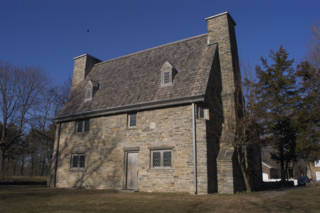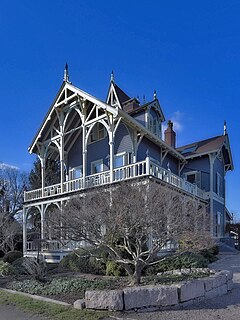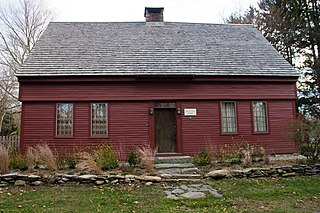
Guilford is a town in New Haven County, Connecticut, United States, that borders Madison, Branford, North Branford and Durham, and is situated on I-95 and the Connecticut seacoast. The population was 22,073 at the 2020 census.

The Henry Whitfield House is a historic house located in Guilford, Connecticut, down the street from the town green. This house dates from 1639, having been built just before the town of Guilford was settled. It is the oldest house in Connecticut and the oldest stone house in New England. The house, with its massive stone walls, also served as a fort to protect the community. Henry Whitfield, for whom the house was built, was a Puritan minister who had come from England to flee religious persecution. The house was remodeled in 1868 and opened to the public in 1899 as the first museum of the State of Connecticut, the Henry Whitfield State Museum. The house was restored in 1902–04 and in the 1930s and was declared a National Historic Landmark in 1997. It was named a State Archeological Preserve in 2006.

The Hyland House Museum or Hyland-Wildman House is a historic house museum at 84 Boston Road in Guilford, Connecticut. Built in 1713, it is one of the town's best-preserved houses of that period. It has been open to the public as a museum since 1918, under the auspices of a local historic preservation group. It was added to the National Register of Historic Places in 1976. The house features Colonial-era furnishings and artifacts.

The Harrison House, also known as Harrison–Linsley House and incorrectly as the Swain-Harrison House, is a historic house museum at 124 Main Street in Branford, Connecticut. Built in 1724 by a descendant of Branford's founders, it is a good example of a Connecticut saltbox structure. The house was listed on the National Register of Historic Places in 1975, and is a contributing property to the Canoe Brook Historic District. Since 2016 it has been operated as a house museum by the Branford Historical Society.

The Acadian House is a historic house on Union Street in Guilford, Connecticut. Built about 1670, it is one of Connecticut's oldest surviving houses, notable for its occupation by refugee Acadians following their 1755 deportation from Nova Scotia. The house was listed on the National Register of Historic Places in 1975.

The Meigs–Bishop House is a historic house at 45 Wall Street in Madison, Connecticut. With a construction history dating to about 1690, it is one of the town's oldest surviving buildings. It was listed on the National Register of Historic Places in 1988. It is now used for commercial purposes.

The William Andrew House, also known as the Richard Bryan House or the Bryan-Andrew House, is a historic house museum at 131 Old Tavern Road in Orange, Connecticut. Built either about 1750 or 1775, it is a well-preserved local example of Georgian colonial residential architecture, and is Orange's oldest surviving building. It was listed on the National Register of Historic Places in 2002. It is now a house museum operated by the local historical society.

The William J. Clark House is a historic house at 32 Prospect Hill in the Stony Creek neighborhood of Branford, Connecticut. Built in 1878–80 to a design by New Haven-based architect Henry Austin, it is a particularly fine example of the Stick style of architecture popular at the time. The house is individually listed for its architecture on the National Register of Historic Places as the Stick Style House at Stony Creek, and is a contributing property to the Stony Creek-Thimble Islands Historic District.

The Jonathan Murray House is a historic house at 76 Scotland Road in Madison, Connecticut. Built about 1690, it is one of a handful of 17th-century houses surviving in the state. The house was listed on the National Register of Historic Places in 1982.

The Thomas Burgis II House is a historic house at 85 Boston Street in Guilford, Connecticut. With a construction history dating to about 1735, it is one of Guilford's finest and best-documented colonial-era houses, standing on property with a documented history to the 17th century. The house was listed on the National Register of Historic Places in 2000.

The Hezekiah Palmer House is historic house at 340-408 Leete's Island Road in Branford, Connecticut. Probably built in the early 19th century, it is an uncommonly late example in the town of colonial Georgian architecture. The house was listed on the National Register of Historic Places on December 1, 1988.

The Edward Frisbie Homestead is a historic house at 240 Stony Creek Road in Branford, Connecticut, United States. Built about 1790 by the grandson of one of Branford's first settlers, it is a little-altered and well-preserved example of Federal period architecture. It was listed on the National Register of Historic Places in 1985.

The John Hoadley House is a historic house at 213 Leete's Island Road in Branford, Connecticut. Built about 1810, it is a well-preserved example of late colonial architecture. It was listed on the National Register of Historic Places in 1988.

29 Flat Rock Road is a historic house in Branford, Connecticut. Probably built in the second half of the 18th century, it is a well-preserved example of a modest period farmhouse, a type of which relatively few now survive in the town. It was listed on the National Register of Historic Places in 1988.

The William Hurd House is a historic house at 327 Hulls Hill Road in Southbury, Connecticut. Built in the late 18th century and enlarged about 1820, it is a good local example of Federal period architecture, with well-preserved outbuildings. It was listed on the National Register of Historic Places in 1993.

The Theophilus Jones House is a historic house at 40 Jones Road in Wallingford, Connecticut. Built about 1740, it is one of the town's oldest surviving buildings, also notable for its restoration in the 1940s by Charles F. Montgomery. It was listed on the National Register of Historic Places in 1992.

The Elisha Pitkin House is a historic house at 173 High Woods Drive in Guilford, Connecticut. With a construction history estimated to date to 1690, it is one of Connecticut's small number of surviving 17th-century buildings. It was moved to this site in 1955 from its original site in East Hartford, and was listed on the National Register of Historic Places in 1979.

The Route 146 Historic District encompasses a historic streetscape in Branford and Guilford, Connecticut. Extending along Connecticut Route 146 between Flat Rock Road in Branford and the West River bridge in Guilford, it includes two centuries of rural residential architecture, and a well-preserved pre-World War II street layout created as a "state assistance road" in the 1920s. The district was listed on the National Register of Historic Places in 1990.

The Ward-Heitman House is a historic house museum at 277 Elm Street in West Haven, Connecticut. Built on or before 1725, it is believed to be the oldest standing house in the former territory of the New Haven Colony. Its rooms house displays of furnishings and objects that might have been used by families that lived here in more than 250 years of residential occupancy. The house was listed on the National Register of Historic Places in 2003.





















